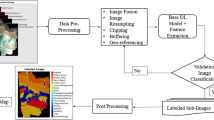Abstract
Nowadays, land use and land cover (LULC) change is a major problem for decision-makers and ecologists on account of its impact on natural ecosystems. In this manuscript, LU/LC change classification and prediction using deep convolutional spiking neural network (DCSNN) and enhanced Elman spike neural network (EESNN) (LU/LC-DCSNN-EESNN) is proposed. The input images are gathered from IRS Satellite Resourcesat-1 LISS-III with Cartosat-1 digital elevation model (DEM) satellite imagery of the Javadi Hills, Tamil Nadu. After that, the images are pre-processed using the fast discrete curvelet transform and wrapping (FDCT-WRP) method is used for extracting the region of interest (ROI) coordinates of Javadi Hills satellite image. Then, for categorizing the area of forest and non-forest, the DCSNN is used. The categorized images are given to post-classification process for eradicating the noise and misclassification errors by Markov chain random field (MCRF) co-simulation approach. The LU/LC changes are predicted using EESNN method. The performance metrics, like precision, accuracy, f1 score, error rate, specificity, recall, kappa coefficient and ROC, are analyzed. The proposed LU/LC-DCSNN-EESNN method has attained 19.45%, 20.56% and 23.67% higher accuracy, 19.45%, 32.56% and 17.45% higher F-measure, and 16.78%, 22.09% and 32.39% lower error rate compared with the existing methods.













Similar content being viewed by others
Data availability
Nil.
References
Alem, A., Kumar, S.: Transfer learning models for land cover and land use classification in remote sensing image. Appl. Artif. Intell. 36(1), 2014192 (2022)
Jamali, A.: Land use land cover mapping using advanced machine learning classifiers: a case study of Shiraz city Iran. Earth Sci. Inf. 13(4), 1015–1030 (2020)
Weng, L., Qian, M., Xia, M., Xu, Y., Li, C.: Land use/land cover recognition in arid zone using a multi-dimensional multi-grained residual Forest☆. Comput. Geosci. 144, 104557 (2020)
Al Kafy, A., Al Rakib, A., Akter, K.S., Rahaman, Z.A., Jahir, D.M.A., Subramanyam, G., Bhatt, A.: The operational role of remote sensing in assessing and predicting land use/land cover and seasonal land surface temperature using machine learning algorithms in Rajshahi Bangladesh. Appl. Geomat. 13(4), 793–816 (2021)
Alqadhi, S., Mallick, J., Balha, A., Bindajam, A., Singh, C.K., Hoa, P.V.: Spatial and decadal prediction of land use/land cover using multi-layer perceptron-neural network (MLP-NN) algorithm for a semi-arid region of Asir Saudi Arabia. Earth Sci. Inform. 14, 1547–1562 (2021)
Girma, R., Fürst, C., Moges, A.: Land use land cover change modeling by integrating artificial neural network with cellular Automata-Markov chain model in Gidabo river basin, main Ethiopian rift. Environ. Chall. 6, 100419 (2022)
Rajagopal R.K., Karthick R., Meenalochini P., Kalaichelvi T.: Deep Convolutional Spiking Neural Network optimized with Arithmetic optimization algorithm for lung disease detection using chest X-ray images. Biomed. Signal Process. Control 79, 104197 (2023)
Alikhan J.S., Alageswaran R., Amali S.M.: Self-attention convolutional neural network optimized with season optimization algorithm Espoused Chronic Kidney Diseases Diagnosis in Big Data System. Biomed. Signal Process. Control. 85, 105011 (2023)
Varma P.R.K., Sathiya R.R., Vanitha M.: Enhanced Elman spike neural network based intrusion attack detection in software defined Internet of Things network. Concurrency and Comput: Pract. Experience. 35(2), e7503 (2023)
Rajesh, P., Shajin, F.H., Kannayeram, G.: A novel intelligent technique for energy management in smart home using internet of things. Appl. Soft Comput. 128, 109442 (2022)
Ahmed, M.H., Lin, L.S.: Dissolved oxygen concentration predictions for running waters with different land use land cover using a quantile regression forest machine learning technique. J. Hydrol. 597, 126213 (2021)
Becker, W.R., Ló, T.B., Johann, J.A., Mercante, E.: Statistical features for land use and land cover classification in Google Earth Engine. Remote Sens. Appl. Soc. Environ. 21, 100459 (2021)
Kafy, A.A., Dey, N.N., Al Rakib, A., Rahaman, Z.A., Nasher, N.R., Bhatt, A.: Modeling the relationship between land use/land cover and land surface temperature in Dhaka Bangladesh using CA-ANN algorithm. Environ. Chall. 4, 100190 (2021)
Memon, N., Parikh, H., Patel, S.B., Patel, D., Patel, V.D.: Automatic land cover classification of multi-resolution dualpol data using convolutional neural network (CNN). Remote Sens. Appl. Soc. Environ. 22, 100491 (2021)
Ansith, S., Bini, A. A.: A modified generative adversarial network (GAN) architecture for land use classification. In 2021 IEEE Madras Section Conference (MASCON) (pp. 1–6) (2021). IEEE
MohanRajan, S.N., Loganathan, A.: Modelling spatial drivers for LU/LC change prediction using hybrid machine learning methods in Javadi Hills, Tamil Nadu, India. J. Indian Soc. Remote Sens. 49, 913–934 (2021)
Sundar, P.K.S., Deka, P.C.: Spatio temporal classification and prediction of land use and land cover change for the Vembanad Lake system Kerala a machine learning approach. Environ. Sci. Pollut. Res. 29(57), 86220–86236 (2022)
Alshari, E.A., Gawali, B.W.: Development of classification system for LULC using remote sensing and GIS. Global Transit. Proc. 2(1), 8–17 (2021)
Diniz, J.M.F.D.S., Gama, F.F., Adami, M.: Evaluation of polarimetry and interferometry of sentinel-1A SAR data for land use and land cover of the Brazilian Amazon Region. Geocarto Int. 37(5), 1482–1500 (2022)
Jagannathan, J., Divya, C.: Deep learning for the prediction and classification of land use and land cover changes using deep convolutional neural network. Eco. Inform. 65, 101412 (2021)
Funding
None.
Author information
Authors and Affiliations
Contributions
AEP contributed to conceptualization, methodology and writing—original draft preparation. MS performed supervision.
Corresponding author
Ethics declarations
Conflict of interest
The authors declare no competing interests.
Ethical approval and consent to participate
Nil.
Consent for publication
Nil.
Human and animal ethics
Nil.
Additional information
Publisher's Note
Springer Nature remains neutral with regard to jurisdictional claims in published maps and institutional affiliations.
Rights and permissions
Springer Nature or its licensor (e.g. a society or other partner) holds exclusive rights to this article under a publishing agreement with the author(s) or other rightsholder(s); author self-archiving of the accepted manuscript version of this article is solely governed by the terms of such publishing agreement and applicable law.
About this article
Cite this article
Ebenezer, P.A., Manohar, S. Land use/land cover change classification and prediction using deep learning approaches. SIViP 18, 223–232 (2024). https://doi.org/10.1007/s11760-023-02701-0
Received:
Revised:
Accepted:
Published:
Issue Date:
DOI: https://doi.org/10.1007/s11760-023-02701-0




